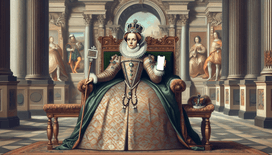Welcome, dear reader, to yet another escapade in time-twisting tales. This time, we're diving headlong into the opulent embrace of the Tudor court, a place where bejewelled hats were as ubiquitous as diplomatic manoeuvrings. Picture gold-embroidered tapestry adoring corridors where whispers of intrigue mingled with the scent of rosemary. And now, imagine these very corridors populated not just with courtiers and jesters, but with the sleek swipe of touchscreen tablets. Today we ask, how would King Henry VIII and his inner circle have harnessed the power of tablets in the business of statecraft, matrimony, and maybe even a spot of jousting? Hold on to your ruffs and let’s parse the potent possibilities of Tudor touch-tech!
Screens at the Stately Court
First things first, let’s address the elephant in the room, or should I say the falcon? Tudor England was no stranger to intrigue, power plays, and a penchant for recording literally everything. If Henry’s courtiers had access to tablets, letters would have gone the way of the dodo quicker than you could exclaim "off with her head!" Hyperbole? Perhaps. But consider this, in a world where meticulous monarchs kept every document under lock and dagger, digital archiving would have been the bee's knees. Imagine the National Archives filled not with dusty parchments, but gleaming rows of illuminated screens!
The Privy Council would likely have maintained an exclusive shared drive. Meeting notes would have been freely accessible, password protected, of course, with the occasional humorous commentary from court favourite Sir Thomas More, "More puns in the library!" Whilst the courier pigeon industry might have experienced a downturn, at least history's correspondence wouldn’t be left to the mercy of damp British weather.
Matrimonial Apps and Gay Courtship
Now onto a subject as weighty as any in the annals of Henry’s reign, his wives. One swishes into speculation as effortlessly as Anne Boleyn wore her French hood. Swipe right on Kings2Wed, the Tudor romance app that may have saved matrimonial heartache and possibly several beheadings. Feedback from disgruntled matchmakings could have been left through star ratings or a sombre "divorce" button, though we suspect such a feature might have suffered a Tudor-style data overload!
Consider the delightfully dramatic exchange of messages between Anne of Cleves and Henry before meeting. Awkward wedding photos, yes, they existed in portrait form, could have been scrutinised with filters and edits. Indeed, with tablets, modern matrimonial chaos might look ridiculously tame compared to Henry’s saga de l'amour.
Tournament LIVE Streams and Royal Commentary
The Tudor love of spectacle required little prompting, from jousting tournaments to lavish masques. Yet to behold them in "real time" via tablet stream would have been revolutionary. Courtiers live-tweeting (or as would be the case, live-quilling) would surely let us know if Henry took a tumble or if the Earl of Essex missed the mark with his lance.
Special shoutout to Catherine of Aragon, known for her dignity and poise. Her post-joust reflections could've made brilliant podcasts, perhaps "Much Ado About Armour", a witty insight into chivalric affairs with her deadpan delivery delighting the Tudor palate.
Social (In)Safety Nets and Reputational Stakes
Social networks in the Tudor era could also fashion quite the quagmire of reputational peril. Gossip in court was the currency of clandestine influence. Courtly faux pas, debates over faux jewels, and marital mishaps could easily become the newest hashtag wars. #AnnulmentAlley might trend just as strongly as #SirLancelot.
Moles at court could operate with subterfuge befitting an espionage thriller, hacking into personal tablets or noting courtly allegiances with a slyly taken screenshot, or commissioned court portrait, whichever the case. For the Tudors already marinated in mutual distrust, paranoia would be doubly spiced by technology’s tantalising possibilities.
Conclusion: Timeless Tablets?
In this alternate reality, tablets might have found themselves as indispensable as Henry’s own Chief Minister, Thomas Cromwell. A tool for power, for politics, and a bit of pompous propriety. What’s clear is that technology, even fictionalised in our historical musings, provides a lens that both extremities of time can peer through to find utility and folly alike.
As we pocket our own devices today with nary a second thought, let’s remember what a little bit of coherence and a lot of curiosity can uncover about our world and its possible paths. The Tudors may not have had their touchscreens, but through imagination, we can certainly offer them their quilled equivalent!







